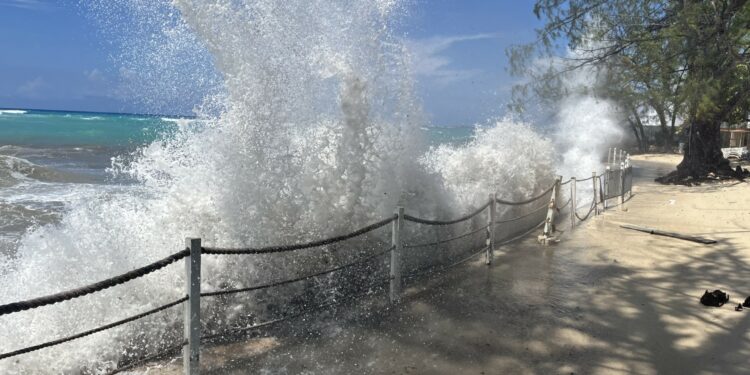Waves impact the coast as Hurricane Milton passes Cayman in October 2024. – Photo: Simon Boxall
The delivery of a hurricane storm surge and wave inundation model for the Cayman Islands and Jamaica, due to be completed by the US National Oceanographic and Atmospheric Administration in 2025, may be in jeopardy, following efforts to cut costs by the Republican administration and the newly created Department of Government Efficiency in the United States.
The National Hurricane Center, which is part of NOAA, is designated by the World Meteorological Organization as the regional specialised meteorology centre for the Caribbean. It is also the tropical cyclone warning centre for the US and all of the countries in the Caribbean Sea.
In response to a question from the Cayman Compass, NHC Deputy Director Jamie Rhome said, “We are working through all the new information now and don’t have an update at this time.”
According to the Wired news organisation, employees at NOAA have “received orders to pause all international engagements”. Scientific American is also reporting that as much as half the workforce at NOAA could be laid off.
The storm surge unit of the National Hurricane Center in Miami had been working on the storm surge and hurricane wave inundation model, which involves running many thousands of hurricane scenarios on super computers, far beyond the scientific capacity and computing power of anything available in the Cayman Islands.
They had been using the high resolution LiDAR bathymetry data provided by and paid for by the UK Government, as a key input for running the model.
Neither the Cayman Islands National Weather Service nor Hazard Management Cayman Islands were able to provide an update on the status of the inundation model, which was expected to have important public safety implications and even support improved development decisions.
The Economic Commission for Latin America and the Caribbean team, which produced the post impact damage assessment following Hurricane Ivan in 2004, estimated that the amount of per capita damage and losses from Ivan was US$75,700 per person in the Cayman Islands, the highest ever encountered by ECLAC, with the majority of the damage resulting from storm surge and wave impacts.
 Deputy Director of the National Hurricane Center Jamie Rhome and then Premier Wayne Panton, both in the centre, pose after the announcement of the inundation model for Jamaica and Cayman in April 2023. – Photo: Cayman Islands Government
Deputy Director of the National Hurricane Center Jamie Rhome and then Premier Wayne Panton, both in the centre, pose after the announcement of the inundation model for Jamaica and Cayman in April 2023. – Photo: Cayman Islands Government
Former Premier Wayne Panton launched an appeal to the RA IV Hurricane Committee, a regional body of hurricane specialists, in 2023 to have the Cayman Islands considered a priority for the programme of surge inundation modelling, in part due to the very high vulnerability of the islands to surge.
“The acceptance of my request to be included with Jamaica in this critically important modelling gave me much comfort that our plans to improve safe evacuation routes, improve storm water management to protect neighbourhoods and of critical importance, to build resiliency in this country could be made stronger with that data,” he said.
“I hope that the situation can be resolved such that the benefits to us become a reality. It is of critical importance for our small country.”
Source link : http://www.bing.com/news/apiclick.aspx?ref=FexRss&aid=&tid=67ad860b51a94de780d8e10939162246&url=https%3A%2F%2Fwww.caymancompass.com%2F2025%2F02%2F13%2Fwith-us-in-flux-critical-hurricane-surge-model-may-be-in-jeopardy%2F&c=9291569894116131898&mkt=en-us
Author :
Publish date : 2025-02-12 16:00:00
Copyright for syndicated content belongs to the linked Source.









